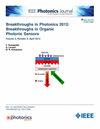大气光学信道随机密钥提取实验研究
IF 2.4
4区 工程技术
Q3 ENGINEERING, ELECTRICAL & ELECTRONIC
引用次数: 0
摘要
利用互易大气湍流作为物理熵源提取随机密钥是实现无线信道物理层安全的有效手段。为了研究湍流强度对大气光通道中密钥提取速率的影响,本文进行了双向同步大气通道激光传输实验,分析了三个不同时间段的实验数据,测试了五种概率分布归一化接收信号的Kolmogorov-Smirnov (KS)拟合效率值。对比分析表明,Johnson SB分布和Log-Normal分布对数据的拟合效果最为理想。基于这些分布参数,建立了关键容量的理论模型。采用蒙特卡罗方法模拟了不同湍流强度和不同概率分布模型下的密钥提取率。分析结果表明,在弱湍流条件下,Johnson SB分布的平均最大密钥提取率比Log-Normal分布的平均最大密钥提取率高87%;在中等湍流条件下,两种分布模型的密钥提取速率没有显著差异。与log -正态分布相比,Johnson SB分布更适合中弱湍流强度下的密钥提取。本文章由计算机程序翻译,如有差异,请以英文原文为准。
Experimental Study of Random Secret Key Extraction From Atmospheric Optical Channels
Utilizing reciprocal atmospheric turbulence as a physical entropy source for extracting random secret key is an effective means to achieve physical layer security in wireless channels. To study the impact of turbulence intensity on secret key extraction rate in atmospheric optical channels, this paper conducted a bi-directional synchronous atmospheric channel laser transmission experiment, analyzed the experimental data from three different time periods, and tested the Kolmogorov-Smirnov (KS) fitting efficiency values for five types of probability distribution normalized received signals. Comparative analysis shows that Johnson SB and Log-Normal distributions have the most ideal fitting effects on data. Based on these distribution parameters, a theoretical model of key capacity was constructed. The Monte Carlo method was used to simulate the secret key extraction rates under different turbulence intensities and different probability distribution models. The analysis results show that under weak turbulence conditions, using Johnson SB distribution yields about 87% higher average maximum secret key extraction rate than using Log-Normal distribution; under medium turbulence conditions, there is no significant difference in secret key extraction rates between the two distribution models. Compared with Log-Normal distribution, Johnson SB distribution is more suitable for secret key extraction under medium to weak turbulence intensities.
求助全文
通过发布文献求助,成功后即可免费获取论文全文。
去求助
来源期刊

IEEE Photonics Journal
ENGINEERING, ELECTRICAL & ELECTRONIC-OPTICS
CiteScore
4.50
自引率
8.30%
发文量
489
审稿时长
1.4 months
期刊介绍:
Breakthroughs in the generation of light and in its control and utilization have given rise to the field of Photonics, a rapidly expanding area of science and technology with major technological and economic impact. Photonics integrates quantum electronics and optics to accelerate progress in the generation of novel photon sources and in their utilization in emerging applications at the micro and nano scales spanning from the far-infrared/THz to the x-ray region of the electromagnetic spectrum. IEEE Photonics Journal is an online-only journal dedicated to the rapid disclosure of top-quality peer-reviewed research at the forefront of all areas of photonics. Contributions addressing issues ranging from fundamental understanding to emerging technologies and applications are within the scope of the Journal. The Journal includes topics in: Photon sources from far infrared to X-rays, Photonics materials and engineered photonic structures, Integrated optics and optoelectronic, Ultrafast, attosecond, high field and short wavelength photonics, Biophotonics, including DNA photonics, Nanophotonics, Magnetophotonics, Fundamentals of light propagation and interaction; nonlinear effects, Optical data storage, Fiber optics and optical communications devices, systems, and technologies, Micro Opto Electro Mechanical Systems (MOEMS), Microwave photonics, Optical Sensors.
 求助内容:
求助内容: 应助结果提醒方式:
应助结果提醒方式:


